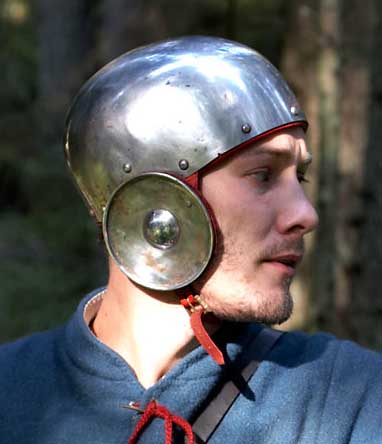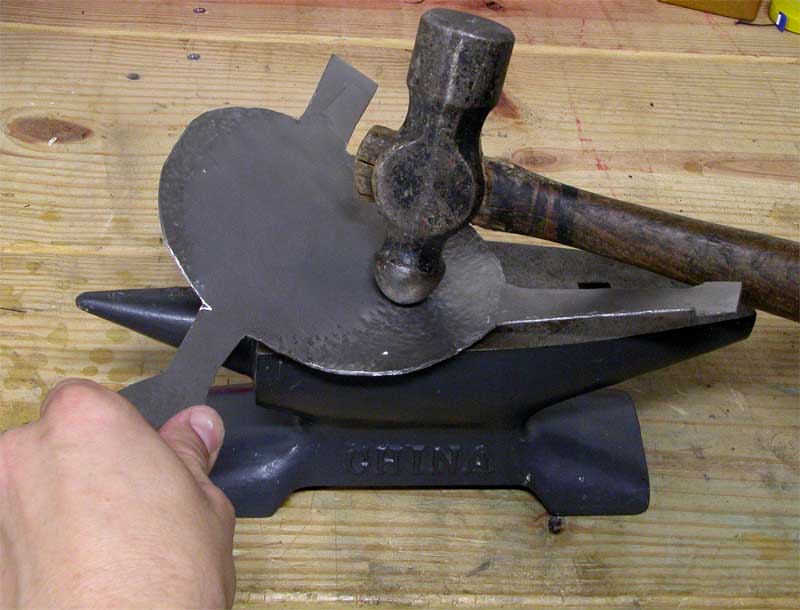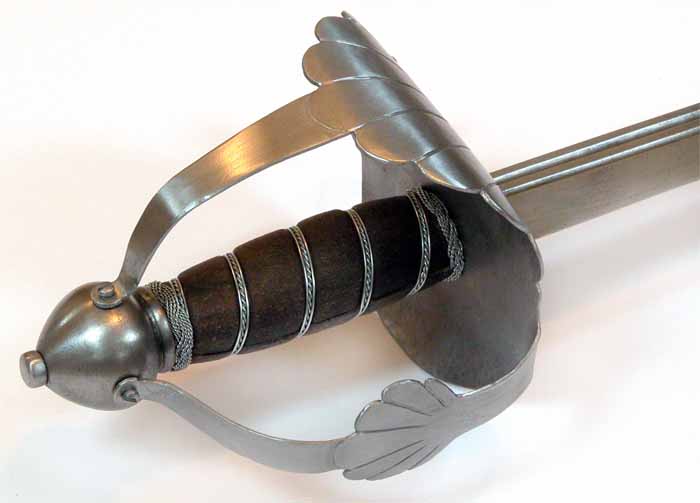| Author |
Message |
|
Phillip H. Lee
|
 Posted: Mon 09 Jul, 2007 7:39 pm Post subject: Easiest medieval metal helmet to make? Posted: Mon 09 Jul, 2007 7:39 pm Post subject: Easiest medieval metal helmet to make? |
 |
|
Hello! (I'm not sure where to put this thread, so I shall place this here in the Off-topic section.)
I'm trying to find out what metal helmet from, say, 500 AD to 1400 AD is easiest to make. I'm looking for the easiest since I have almost no experience in metalworking.
This helmet is for a school project and is due sometime in mid December, so time isn't too big of an issue. Ease of manufacture, however, is. I am somewhat limited financially as well and I have little to no acess to advanced metal cutting equipment.
Currently, I suspect that the nasal helm and the kettle helm are the easiest. What say you, myArmoury folks?
|
|
  |
 |
|
Lafayette C Curtis
|
 Posted: Mon 09 Jul, 2007 8:11 pm Post subject: Posted: Mon 09 Jul, 2007 8:11 pm Post subject: |
 |
|
|
I'd agree with that. However, it might be even easier to do helmets joined from several pieces of metal (as opposed to being raised from a single sheet of steel), such as the spangenhelm. Some kettle-hats might have been made this way too, though I'm not sure about it.
|
|
  |
 |
|
Phillip H. Lee
|
 Posted: Mon 09 Jul, 2007 8:17 pm Post subject: Posted: Mon 09 Jul, 2007 8:17 pm Post subject: |
 |
|
Ah, I should also mention: no welding for me. It is highly preferable that I bang this helmet into shape out of one piece and perhaps rivet the rest.
...I'm really limiting my options, aren't I? 
|
|
  |
 |
Chad Arnow
myArmoury Team


|
 Posted: Mon 09 Jul, 2007 8:19 pm Post subject: Posted: Mon 09 Jul, 2007 8:19 pm Post subject: |
 |
|
I agree a spangenhelm or a kettlehat would be good. A number of kettlehats were made in pieces.
Here's another option: a great helm. If you have cut sheet out, hammer some curves into the pieces and rivet it together, you should be able to make one.

ChadA
http://chadarnow.com/
|
|
    |
 |
|
Reinier van Noort
|
 Posted: Tue 10 Jul, 2007 1:19 am Post subject: Posted: Tue 10 Jul, 2007 1:19 am Post subject: |
 |
|
I have to agree that the Greathelm should be the easiest. Added bonus: no compound curves (only cylindrical ones).
Find a pattern on armourarchive; there's also a pdf floating around the internet (don't remember where) that explains all and costs 5 dollars or so, try out the pattern first on linoleum or cardboard to see if it fits, then cut it out of steel (an electric jigsaw would help). For mine I used 1.5mm steel (~16 gauge); a little thinner is easier to cut, but this worked excellent. Bend the plates over a piece of pipe, and rivet it all together.
It really is quite easy.
School voor Historische Schermkunsten
www.bruchius.com
|
|
   |
 |
Elling Polden

|
 Posted: Tue 10 Jul, 2007 1:49 am Post subject: Posted: Tue 10 Jul, 2007 1:49 am Post subject: |
 |
|
Actually, i suspect that the easiest ones would be one of the Quick n' Diry models from the crusading eras;
the coronett helmet, or one of the "lampshade" kettlehatts.
Alternately, two piece cervilet shouldn't be to hard.
These have less pieces and simpler shapes than the spang og greathelm.
"this [fight] looks curious, almost like a game. See, they are looking around them before they fall, to find a dry spot to fall on, or they are falling on their shields. Can you see blood on their cloths and weapons? No. This must be trickery."
-Reidar Sendeman, from King Sverre's Saga, 1201
|
|
    |
 |
|
Reinier van Noort
|
 Posted: Tue 10 Jul, 2007 2:09 am Post subject: Posted: Tue 10 Jul, 2007 2:09 am Post subject: |
 |
|
Well, I've made a lampshade and a greathelm and found the greathelm the easiest to make. It is also easier to find a pattern for that (and making your own pattern takes some time, insight and trial-and-error).
School voor Historische Schermkunsten
www.bruchius.com
|
|
   |
 |
Sean Flynt

|
 Posted: Tue 10 Jul, 2007 8:20 am Post subject: Posted: Tue 10 Jul, 2007 8:20 am Post subject: |
 |
|
I'm not sure when it first appeared, but the simple iron skullcap or "archer's sallet"-very simple bowl shapes--were common by the mid 14th c. You might be able to form one of those with a hammer, small anvil and makeshift raising stake.
I found it pretty easy to form the shell of the hanger shown below using only a $25 anvil, hammer and a cheap sheet of 16 ga. steel from Lowe's. I've never made a helmet or anything larger than this piece, so I don't know if it's possible to coax out a full bowl. Anyway, forming this much--maybe 1/5th of a bowl--was no problem at all. You could certainly use this method to form plates to be joined by welding or rivetting. I doubt you could form a deep bowl this way. At some point you'd run out of room to move the hammer inside the bowl. Then you'd need a stake inside so you could hammer freely outside the bowl. I'm just now trying to figure out what would work as a stake without costing much of anything.
Here's a simple but very cool late 15th c. helmet from the galleries at the Guild of Stl Olaf pages:
 Attachment: 57.72 KB Attachment: 57.72 KB

 Attachment: 87.92 KB Attachment: 87.92 KB

 Attachment: 57.65 KB Attachment: 57.65 KB

-Sean
Author of the Little Hammer novel
https://www.amazon.com/Little-Hammer-Sean-Flynt/dp/B08XN7HZ82/ref=sr_1_1?dchild=1&keywords=little+hammer+book&qid=1627482034&sr=8-1
|
|
   |
 |
|
Phillip H. Lee
|
 Posted: Wed 11 Jul, 2007 4:40 pm Post subject: Posted: Wed 11 Jul, 2007 4:40 pm Post subject: |
 |
|
Thank you for the replies!
What do you guys think of an early great helm, a la: 
This LOOKs easy enough...too bad I can't find any patterns for this though...
|
|
  |
 |
Nathan Keysor

|
 Posted: Wed 11 Jul, 2007 6:09 pm Post subject: Posted: Wed 11 Jul, 2007 6:09 pm Post subject: |
 |
|
i believe Doug Strong at TalbotsFineAccessories.com sells the pattern for that helm...And yes that is a fairly easy design to make. Just get a stump and make a depression in it and you can dish out the compound curves.
Nathan
"Democracy is two wolves and a lamb voting on what to have for dinner.
Liberty is a well-armed lamb contesting the vote!"
|
|
  |
 |
Robin Smith

|
 Posted: Wed 11 Jul, 2007 7:22 pm Post subject: Posted: Wed 11 Jul, 2007 7:22 pm Post subject: |
 |
|
Though I love this style of helm, I don't know if I'd call it a good first project. With no experience, you are going to find the compound curve in the faceplate difficult to pull off looking nice. I think the suggestion of a simple kettlehat with an angular top, or a fully developed greathelm, are by far the most practical. No compound curves to contend with.
A furore Normannorum libera nos, Domine
|
|
   |
 |
|
Phillip H. Lee
|
 Posted: Thu 12 Jul, 2007 7:12 am Post subject: Posted: Thu 12 Jul, 2007 7:12 am Post subject: |
 |
|
| Robin Smith wrote: | | Though I love this style of helm, I don't know if I'd call it a good first project. With no experience, you are going to find the compound curve in the faceplate difficult to pull off looking nice. I think the suggestion of a simple kettlehat with an angular top, or a fully developed greathelm, are by far the most practical. No compound curves to contend with. |
Duly noted.
Just wondering, what exactly is a compound curve?
|
|
  |
 |
|
Reinier van Noort
|
 Posted: Thu 12 Jul, 2007 9:46 am Post subject: Posted: Thu 12 Jul, 2007 9:46 am Post subject: |
 |
|
A curve along more than one axis
So while a cylinder (for instance a whine bottle) has a curve along only one axis, a globe (basketball for instance) has a curve along two (perpendicular) axes.
School voor Historische Schermkunsten
www.bruchius.com
|
|
   |
 |
Nathan Keysor

|
 Posted: Thu 12 Jul, 2007 9:51 am Post subject: Posted: Thu 12 Jul, 2007 9:51 am Post subject: |
 |
|
it's basincally a convex shape like the faceplate on that helm. If you roll a piece of paper you are only curling it in one direction. If you make something out of metal you can get it to curve in multiple directions. I don't consider this too hard to do. I dished helmet tops, knees and elbow cops with a hollowed out stump and a ballpein hammer when I was a teenager. It's a lot easier if you have a rawhide mallet and a steel dishing form but that doesn't mean it can't be done.
"Democracy is two wolves and a lamb voting on what to have for dinner.
Liberty is a well-armed lamb contesting the vote!"
|
|
  |
 |
Chuck Russell

|
 Posted: Sun 15 Jul, 2007 1:10 pm Post subject: Posted: Sun 15 Jul, 2007 1:10 pm Post subject: |
 |
|
|
the easiest helmet to make would be one of the 5th century. its 2 helm halves with a central band holding them together and a brow band.
|
|
    |
 |
|
|

